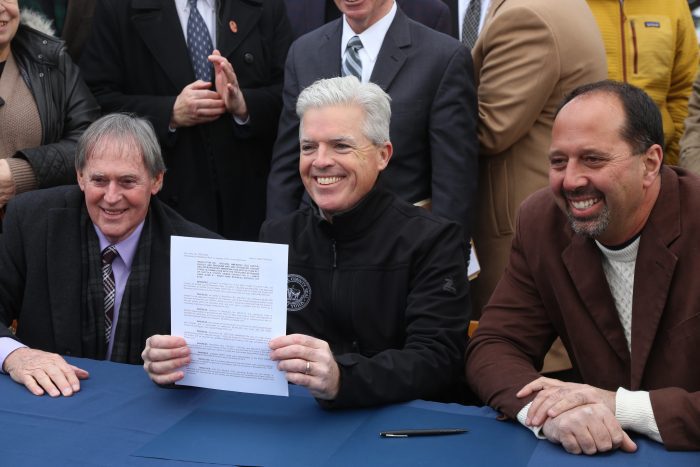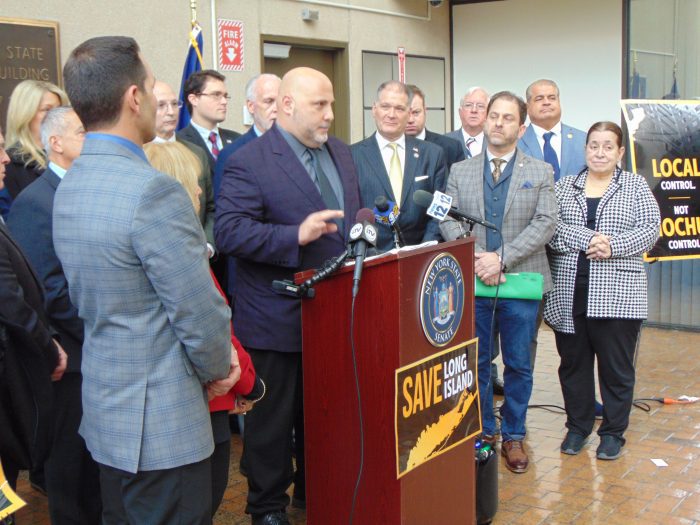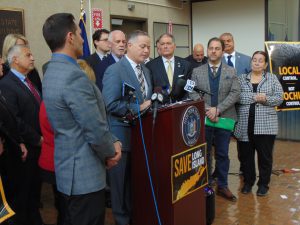An East Setauket couple’s walk along the beach led to a memorial bench returned to its rightful place — in Connecticut.

After 50 years living in the Three Village area and countless walks along West Meadow Beach, Diane and Bob Wattecamps know the landscape like the backs of their hands.
While walking on the beach one day at the end of January, the couple embarked on an unexpected adventure. Diane Wattecamps pointed out a bench to her husband that caught her eye the day before on a windy day. It was a large bench made from teakwood lodged at the beach’s pavilion. The couple stopped to examine the piece covered with sand and seaweed. First, they found a bronze memorial plaque hanging from a screw on the bench.
“Bob just put his hand on the plaque, and it just came off in his hand,” said the wife. “He said, ‘Wow, this thing was just literally hanging on.’”
After closer inspection, the Wattecamps found another plaque in the sand and realized they belonged to a couple named Nahum and Judy Hacohen. They knew that not only did this bench not belong on their favorite beach, but it was also something special.
Diane Wattecamps said after reading the plaques, she could picture the couple sitting by the water somewhere, enjoying the view. One plaque dedicated to Nahum Hacohen read, “What a view.” Judy Hacohen’s plaque is inscribed with “I’ve said that since 1936.”
After she and her husband found the plaques, the Three Village resident said she took out her cellphone to search for the names, and she found the wife’s obituary immediately. It turned out she was an 81-year resident of Bell Island in Norwalk, Connecticut. The couple then decided to load the heavy bench into their truck.
“I have to find where it belongs,” Diane Wattecamps said to her husband.
A former TBR News Media employee for 30 years, the wife said she got home and started to read the obituary carefully. She found the children’s names and searched for them on the internet. One had a landline listed, Lee Hacohen.
“I guess it’s the curiosity in my personality that I couldn’t leave it,” she said.
She called and left a message for the Hacohens’ son. He returned the call within five minutes and was surprised to hear from her.
It turned out the bench had been missing since November from Bell Island located across the Long Island Sound. It was believed the bench traveled more than 17 nautical miles after a nor’easter.
Lee Hacohen asked if Diane Wattecamps could stay on the phone while he contacted his brother Dean who still lived on Bell Island.
After talking to them, Dean Hacohen said he would come the next day, even though the couple were happy to drive it to Connecticut, but Dean wanted to get the bench back as soon as possible and said his neighbor could come to help.
In the meantime, family members sent Bob and Diane Wattecamps photos of the Bell Island couple. They also shared pictures of the grandchildren sitting on the bench, including Dean Hacohen’s daughter and son-in-law on their wedding day.

Dean Hacohen said a neighbor had initially noticed that the bench, one of three at a neighborhood park at a spot called Rocky Point, was missing at the end of last year. At first, they thought maybe someone had taken it. While it’s heavy, two people can pick it up. Then a neighbor pointed out that there were nor’easters back in November. Since the benches are unsecured and people move them around the neighborhood park, Hacohen said it was assumed the bench was probably left by the water and washed away in a storm. The hope was that it would turn up along a neighboring Connecticut beach, and he posted on the Nextdoor app to see if anyone found it, but no one had.
When Diane Wattecamps called, he said he never “imagined in my wildest dreams” that it would be found on Long Island.
Before they received the call, the Hacohens were researching online how much a bench would cost to replace the original one.
“I kept putting it off and hoping that maybe some miracle would happen, but I really didn’t think it would,” Dean Hacohen said, adding he wasn’t sure how the bench made it in one piece, especially with boats on the water.
He and his neighbor took the ferry to Port Jefferson and drove straight to Diane and Bob’s home. When they got there, the bench was in the portico with a sign, “USS Hacohen.”
“It was a glorious moment,” he said. “It really was.”
He added some might say it’s just a bench. “On the other hand, it was kind of a memorial, a tombstone, something in the way people go to the cemetery and sit with their loved ones,” he said.
Often, Hacohen said, when family members come to visit from California, they will go to the park to sit on the beach shortly after arriving.
“They go out to the park, sit on the bench, look out at the water, ground themselves,” he said. “I don’t know, somehow sitting there is very grounding.”
The bench was initially dedicated to his father in 2009. “What a view,” was one of his favorite expressions when he came down to the park and took in the sight of nearly 360 degrees of water and islands. Dean Hacohen said his mother enjoyed sitting on the bench after her husband’s passing. He said both inscriptions capture the father’s and mother’s personalities.
Hacohen said when he inspected the bench upon seeing it, he was surprised that it was only a little “banged up.”
Dean Hacohen said his parents loved cruises, and his father was in the passenger cruise ship business in the 1960s, so it wasn’t a surprise the bench took them on one more trip on the water together.
“The two of them together must have been on that bench heading for Long Island,” Hacohen said.
Since the reunion, the story has caught the attention of News12 and NBC Channel 4 — with videos online — and The Norwalk Hour newspaper. Diane Wattecamps was surprised by all the attention even though she found connecting with the Hacohens heartwarming. She and her husband, Wattecamps said, plan to keep in touch with the family.
Hacohen called Diane Wattecamps “a real detective.”
“You’ve got to be born with that gene to want to use it,” he said. “Most people would have just walked by the bench and said, ‘Oh, It’s an old bench that washed up.’”


























